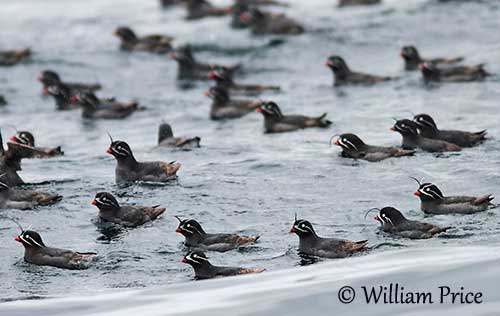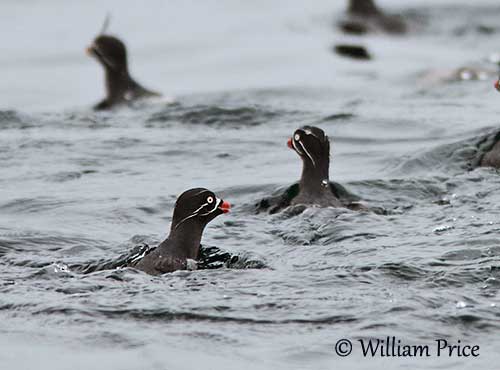
Fr: Starique pygmée
Ang: Whiskered Auklet
All: Bartalk
Esp: Mérgulo Bigotudo
Ita: Alchetta baffuta
Nd: Geoorde Dwergalk
Sd: Plymalka
Photographer:
William Price
PBase-tereksandpiper & Flickr William Price
Text by Nicole Bouglouan
Sources:
HANDBOOK OF THE BIRDS OF THE WORLD Vol 3 by Josep del Hoyo-Andrew Elliott-Jordi Sargatal - Lynx Edicions - ISBN: 8487334202
What Bird-The ultimate Bird Guide (Mitchell Waite)
Wikipedia, the free encyclopaedia
SORA Searchable Ornithological Research Archive (Blair O. Wolf)
Distribution and population status of Whiskered Auklet in the Aleutian Islands, Alaska
Alaska Seabird Information Series - WHISKERED AUKLET Aethia pygmaea
Breeding Biology of the Whiskered Auklet (Aethia pygmaea): Postnesting Period
Whiskered Auklets Aethia pygmaea, foxes, humans and how to right a wrong
Vocal repertoires of auklets (Alcidae: aethiini): structural organization and categorization
Whiskered Auklet
Aethia pygmaea
Charadriiformes Order – Alcidae Family
INTRODUCTION:
The Whiskered Auklet is a small Alcidae confined to remote parts of the Aleutian Islands in Alaska. This secretive seabird is active mostly at night around the breeding colonies.
Like the Crested Auklet, it has a distinctive citrus-like odour to its plumage. This scent produced by some tiny feathers of the shoulder area, is used to repel ticks, but also in social behaviour and between mates.
The Whiskered Auklet breeds on rocky islands and forages in nearby waters. Like other Alcids, it dives and swims (or flies) underwater. It attends its breeding islands all year round, and probably winter in the same area.
The species is threatened by invasive species on the breeding sites. The birds from Kuril Islands (race camtschatica) were formerly considered a subspecies, but recent studies confirm only a single full species.

DESCRIPTION OF THE BIRD:
Biometrics:
Length: 17-18 cm
Wingspan: 37 cm
Weight: 100-136 g
The Whiskered Auklet adult has blackish upperparts and breast, and pale greyish-white belly.
The head pattern is unique, with a long, thin, recurved dark crest on the forehead that drops forwards over the bill, and there are three thin white tufts of facial plumes contrasting with the blackish head, two from the upper base of the bill, and the third on the rear of the eye.
The stout bill is red with pale tip. The eyes are white. Legs and webbed feet are greyish to pale blue. Webs are blackish with dark claws.
Male and female have similar plumage, but the female is smaller overall. During winter, the adults have shorter crest and less distinct facial white plumes.
The juvenile resembles adult in winter but the crest is absent and the bill is dull yellow with dark tip, or all dark. This plumage is retained until the first summer.
RANGE:
The Whiskered Auklet is endemic to a group of islands, from the Aleutian Islands in Alaska to Commander and Kuril islands of Russia.
It winters near the breeding sites, occasionally S as far as Japan, and casual in N Bering Sea.
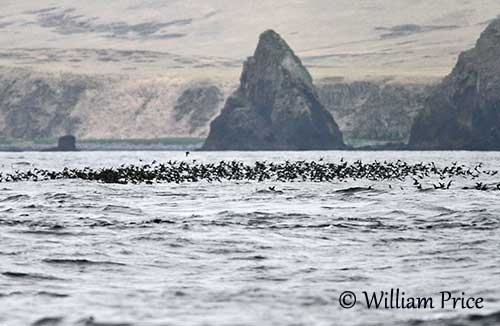
HABITAT:
The Whiskered Auklet breeds on rocky islands with nests among rocks or in cliffs, usually on bare or slightly vegetated slopes, on stony beaches and lava flows on high slopes. The species occurs from high water mark to tops of rocky slopes and cliffs.
It forages in nearby, relatively shallow waters. It often favours rough water and “passes” between islands where it moves easily.
CALLS AND SONGS: SOUNDS BY XENO-CANTO
The vocalizations of the Whiskered Auklet have been recently studied and described, and several call types are now identified.
The bird gives a series of simple descending notes, followed by a “kirree” note and a series of musical notes that become longer progressively. This is the advertising display at night near the colonies.
Before dawn, the bird utters a long, graded trill starting with brief descending notes that increase progressively in duration, amplitude and frequency.
A rapid vibrant duet comes from inside the nest-crevice while one mate enters the burrow in which the other is present “kree…kree…kree…”
Before leaving the breeding burrow, they give a brief call similar to a barking dog.
Contact calls such as “kik”, “mew”, “kreew” or nasal notes are given by a single bird, duetting pairs or several birds in chorus.
BEHAVIOUR IN THE WILD:
The Whiskered Auklet feeds primarily on small crustaceans including copepods, euphausiid shrimps or krill, and amphipods. It also takes molluscs and marine worms.
Small crustaceans, and especially copepods, are taken during the summer in the Aleutian Islands, whereas euphausiid shrimps are mostly taken during winter in E Aleutians.
It forages near the shores, and often within 10 kilometres from the breeding colonies. They gather in flocks around abundant food sources. They usually feed in shallow water, not exceeding 100 metres depth, and also in rough water in “passes” between islands where zooplankton is concentrated.
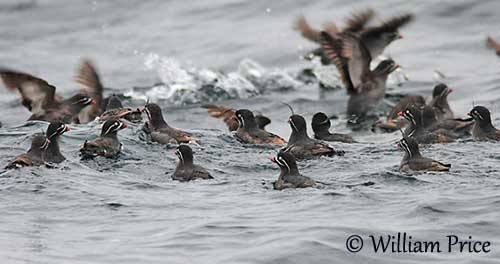
The Whiskered Auklet is built for marine life. Its streamlined body and strong breast muscles allow the bird to move easily both through air and water. It dives from the surface, and swims (or flies) underwater. It propels itself with wings and webbed feet. It is able to reach great depths while searching for food.
During the breeding season, the Whiskered Auklet breeds in colonies where it is mainly nocturnal. The courtship displays are poorly known, but we can suggest that the recurved crest and the white facial plumes are enhanced by adapted postures and movements usually on land, whereas the copulation apparently occurs only in the water. They are probably monogamous, but extra-pair copulations may occur, despite “mate guarding” during the fertile period of the female. Aggressive disputes may occur between males.
The Whiskered Auklet appears to be a year-round resident near the breeding sites. It remains near the coastal waters of the Aleutian, Commander and Kuril Islands, with some observations as far as Japan.
It returns to the colony in April/early May, and leaves by early September.
Like most Alcids, it is a good flier, both through the air and underwater.
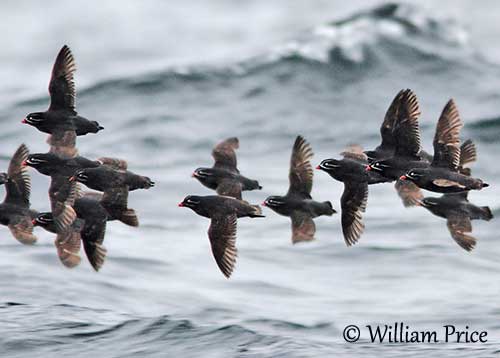
REPRODUCTION OF THIS SPECIES:
The breeding season takes place between May and August, with the laying in late May/early June.
The Whiskered Auklet breeds in colonies and the density is related to availability of suitable habitat. It often nests with other Alcids such as Crested Auklet and Least Auklet. It generally breeds at lower densities than other Alcids in mixed colonies.
It nests in rock crevices with 1-4 entrances (usually only one). The entrance is narrow to avoid larger predators (gulls). There is a nest-chamber, and the floor is sometimes covered with pebbles. It may adopt abandoned storm-petrel’s burrows.
The female lays a single white egg, and both adults incubate during 35-36 days. The semi-precocial downy chick is fed by both parents. They forage at night to avoid predators once at the colony. The young bird fledges between 35 and 46 days after hatching and is fully feathered. It leaves the colony after dark by flying to the sea.
Adults and juveniles return to the colonies after the young have fledged, and they roost on boulders, making them vulnerable to foxes at night.
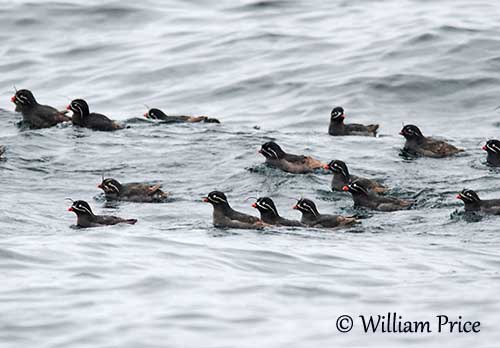
PROTECTION / THREATS / STATUS:
The Whiskered Auklet is threatened by predation, both at sea and on land. The adults are preyed upon by Peregrine Falcon, Bald Eagle and gulls. Mammalian predators including Arctic foxes and Norway rats have been introduced to the breeding islands.
The Whiskered Auklet is vulnerable to oil spills, fishing nets and fatal attraction to ships’ lights at night, resulting in collisions. In addition, other auklet species may kill the chicks within the colonies. The nocturnal fishing activities are a serious threat near the breeding colonies.
The numbers are poorly known, but an estimate in 1990s indicated at least 100,000 individuals (75,000 in E Aleutians and 25,000 in Russia). But by 2003, the Aleutian population was estimated at 116,000 individuals, and 30,000 pairs on Buldir Island in W Aleutians. In W, there are 2000 birds on Yama Island (Commander Islands) and 1000 pairs in N Sea of Okhotsk.
The Whiskered Auklet is currently evaluated as least Concern.
